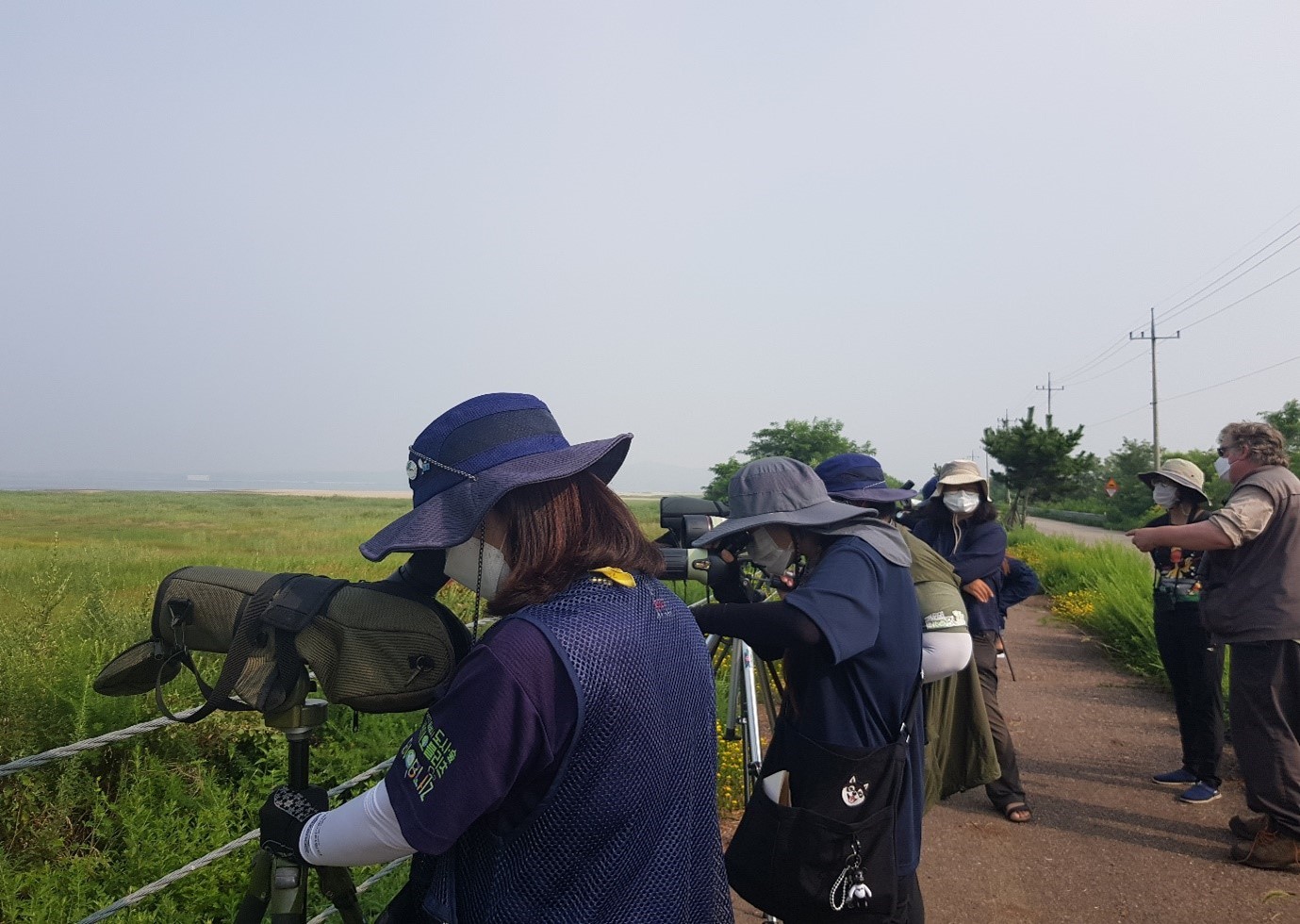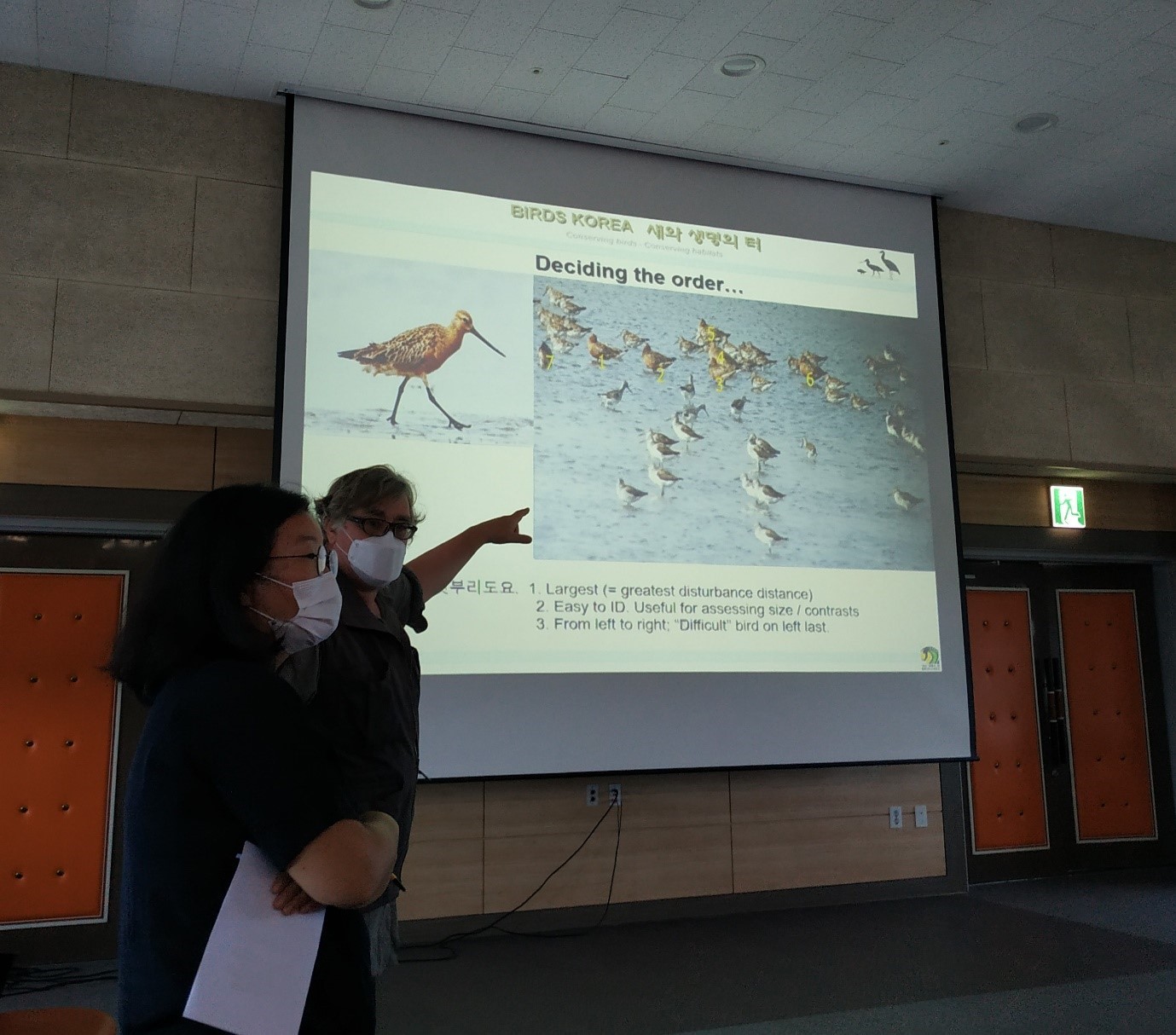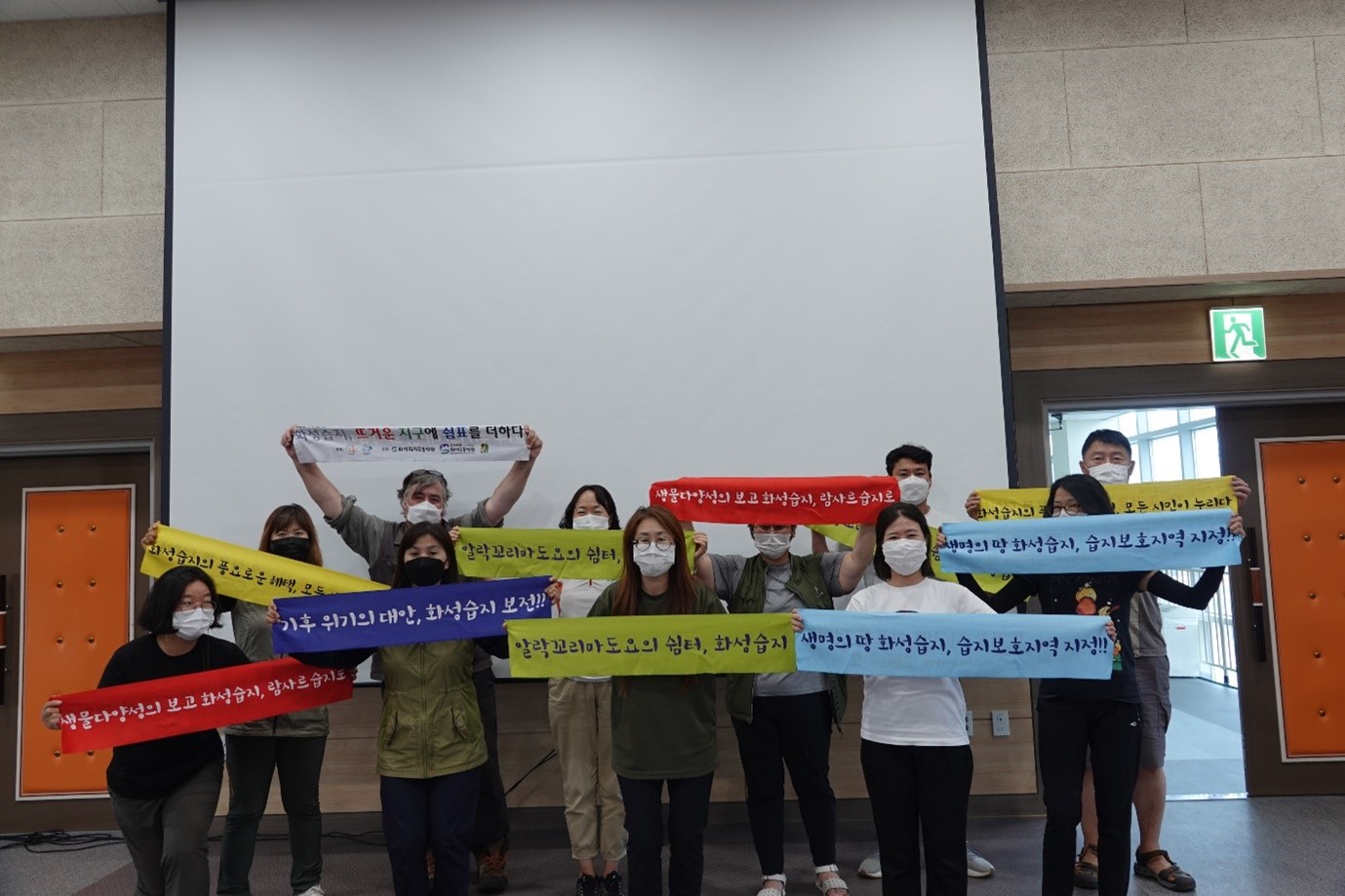 Field work of the warden training at the Hwaseong Wetlands ©KFEM Hwaseong
Field work of the warden training at the Hwaseong Wetlands ©KFEM Hwaseong
A workshop for training the future local wardens to conserve the Hwaseong Wetlands, Ro Korea, was organized by Birds Korea for five days from 9th to 13th August 2021, with the support of the EAAFP Secretariat, and the Hwaseong Eco Foundation.
The Hwaseong Wetlands FNS (EAAF142) has joined the Flyway Site Network since 2018, and the EAAFP Secretariat has been trying to support its conservation for years. Effective conservation of an important site needs site management. Thus, the EAAFP Secretariat and Birds Korea suggested to recruit wardens for the wetlands and provided this training workshop to the Hwaseong Eco Foundation and Hwaseong City. As a result, the training on wardening, wetlands and shorebirds was organized, and another training workshop on Anatidae will happen for five days in November.
The lecturer was Dr. Nial Moores, Director of Birds Korea, and a leading organizer of the training. Korean sequential interpretation was provided. Seven trainees recommended by the local civil society and the local governmental authorities, and staff of the Secretariat attended they training. The training program consisted of indoor lectures and outdoor practical trainings at the Hwaseong Wetlands FNS and its adjacent areas to practice what they had learned at the indoor classes through the five days.
[Curriculum in Korean and English]
 Dr. Nial Moores as the lecturer and Dr. Lee Jiwone, interpreter at the lecture during the Hwaseong Wetlands Warden Training Workshop ©EAAFP
Dr. Nial Moores as the lecturer and Dr. Lee Jiwone, interpreter at the lecture during the Hwaseong Wetlands Warden Training Workshop ©EAAFP
During the indoor activities, there was a class about bird watching and habitats. Dr. Moores explained the relationship between ecological features of birds and wetlands by explaining Ramsar Sites Criteria 2, 5, and 6. Meeting the Criterion 2 means the site has unique ecological niches that supports species which are globally threatened (I.e. CR, EN and VU under IUCN red list). The criterion 5 represents to evaluate the productivity of wetland, it regularly supports 20,000 or more waterbirds. Criterion 6 “the site regularly supports 1% of the individuals in a population of one species or subspecies of waterbird”, indicates which species that we should target for the conservation of the site.
Furthermore, based on the understanding of the previous classes regarding the birds’ habitats, participants shared their bird watching experiences. The lecturer pointed out bird watchers should focus on the structure of birds first, then contrast of birds’ bodies and plumage lastly. The trainees practiced the activities that Dr. Moores had prepared. They worked with pairs: one person observes the bird picture and then identified it, based on the bird’s habitat, structure, and contrast. After describing, the other person who didn’t see the birds’ pictures draw the birds and compared how close the drawings and the bird pictures. At the end of the class, Dr. Moores highlighted to learn birds from what you observed, rather than book knowledge.
The participants said that the teaching method was impressive. “I enjoyed the paired activities for bird watching. Moreover, it was productive time to understand the meaning of the criteria 2, 4, and 5 of Ramsar Sites.”
Another warden training will be held in November, focusing on Anatidae.
Photos: Flickr album
A blog post of Birds Korea written by Dr. Nial Moores: Hwaseong Shorebird Spectacular, August 9th-15th
Written by Ms. Hyoeun Kim, Programme Assistant

The Hwaseong Wetlands Warden Training Workshop ©EAAFP
제 1회 화성습지 보전을 위한 지역관리자 양성 교육(2021년 8월, 한국)
8월 9일부터 13일까지 5일간 새와 생명의 터는 EAAFP 사무국, 화성시환경재단의 지원을 받아 화성습지 보전을 위한 지역 관리자 양성 교육을 진행하였다. 한국의 화성습지는 2018년 EAAFP의 철새이동경로 서식지 네트워크에 들어있으며(EAAF142), EAAFP 사무국에서는
화성습지의 보전을 위한 지원을 하고 있다. EAAFP 사무국과 새와 생명의 터에서 화성시환경재단에 관리자 및 지킴이 제도와 교육을 제안하여, 2021년 8월에 5일 진행하였고(습지, 습지 관리, 도요물떼새), 11월에 5일(오리기러기류 위주) 진행할 예정이다.
사업의 추진자인 새와 생명의 터 나일 무어스 대표가 강의를 진행하였고, 한국어 통역이 제공되었다. 지역사회 및 시의 추천을 받아 선별된 7명의 교육생 및 EAAFP 사무국 직원들이 참여하였다. 교육과정은 실내 이론교육과 현장 실습으로 구성되었다. 교육생들은 이론수업에 배운 내용들을 활용하기 위하여 매일 화성습지와 인근 지역으로 나갔다.
수업탐조와 새의 서식지에 대하여 강의하였다. 강사는 람사르 습지 가입 분류 기준에서 2, 5, 6번을 예시로 들어 새와 습지의 생태적 작용을 설명하였다. 2번 국제적 멸종위기 동-식물종 또는 아종이(IUCN 적색목록 기준 위급, 위기, 취약) 집단으로 서식하거나 이들 종의 개체수가 상당수 서식하고 있는 습지라는 기준은 그 멸종위기의 종이 살 수 있는 특이한 생태적 지위(Ecological niche)를 지녔다는 의미이다. 5번 기준의 경우 20,000 마리 이상의 물새가 정기적으로 서식하는 습지로 이는 습지가 풍부한 생산성을 가지고 있음을 의미한다. 6번 기준 “물새의 종 또는 아종의 전세계 서식지의 1% 이상이 정기적으로 서식 또는 번식하는 습지”가 의미하는 바는, 어떤 종을 집중적으로 보전할지를 알려준다.
또한, 새의 서식지 교육을 바탕으로 셋째 날부터 본격적인 탐조 방식을 공유하는 시간을 가졌다. 강사는 탐조의 기초는 새의 구조 이해부터 시작되며, 구조(structure), 대조(contrast), 깃털(plumage) 순서로 관찰하는 방식을 알려주었다. 탐조에 나가기 전 탐조 방식을 복습하기 위해, 강사가 준비한 활동을 진행하였다. 짝을 지어, 한 사람은 새를 보고, 새의 서식지, 구조, 깃털의 대조와 모양을 바탕으로 새를 설명하여 새의 사진을 보지 못하는 다른 상대가 그림을 그리도록 하는 활동을 진행하였다. 나일 무어스 박사는 새를 공부할 때 책에서 지식을 외우기보다는 직접보면서 배우라고 강조하였다.
이후, 실질적인 습지관리, 지역관리자의 중요성 및 자료 정리에 대해 교습하였다.
교육생들은 이번 교육에서 교육 방식이 가장 인상깊었다고 한다. “짝을 지어 진행한 활동이 기억에 남는다. 또한, 람사르 기준의 의미를 배워서 알찬 교육이었다.“
지역관리자 양성 교육은 11월 중에도 5일 진행될 예정이다.
사진 : Flickr 앨범
새와 생명의 터 블로그 포스터- 이지원 박사 작성 : 화성습지와 도요물떼새, 지역관리자 교육 8/9-8/13
김효은 프로그램 연구원 작성




